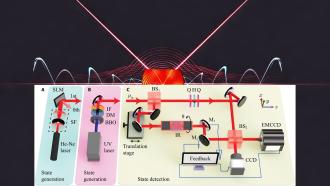
Photo by Faris Mohammed on Unsplash
When we think of sturdy materials, papers aren't anywhere on the list. But did you know that an ordinary sheet of paper, if cut and folded in a specific way, can bear the weight of a brick? The creases, pleats and the resulting three-dimensional structure can impart strength to the otherwise fragile paper. This art of folding paper, called origami, has helped scientists design novel folding patterns for developing engineered materials, resulting in a surprising range of applications from foldable microscopes to solar panels. These folding patterns can also be used to modify various physical properties, including elasticity, electromagnetism and acoustics.
Most materials, like a rubber band, become thinner on its sides when stretched along its length. However, auxetic materials have a unique property. They instead become thicker (or thinner) widthwise when stretched (or compressed) lengthwise. Auxeticity enhances the strength of the material by increasing its hardness and resisting dents. Interestingly, auxeticity can be artificially introduced in materials by creating unique fold patterns. They can be folded compactly and expanded for use when required. With the right crease pattern, most materials, from paper to polymer, can be utilized for modulating multiple physical properties.
A recent study published in the journal Applied Materials Today presents an origami-inspired material whose auxeticity can be changed in more than one direction. The study was carried out by a team of researchers at the Indian Institute of Technology Kanpur (IIT Kanpur), Dalian University of Technology, China, University of Nevada, USA and University of Oxford, UK.
A negative Poisson's ratio determines auxeticity in a material. Poisson's ratio gives an idea of how much strain material experiences widthwise, as compared to lengthwise when stretched along its length (or vice-versa). In this study, the researchers have calculated the Poisson's ratio of the origami-inspired material and have mathematically shown how the geometry of the folding pattern and the folding angle determine its auxeticity.
"The aim was to combine the artistic side of origami with scientific aspects of materials science," says Dr Tanmay Mukhopadhyay. He is an assistant professor at IIT Kanpur and an author of the study. "Our motivation was to develop origami-based material that can show auxeticity in many directions with tunable features," he adds, talking about the motivation behind the study.
The researchers propose a hybrid fold pattern which is a combination of two designs—the Miura-ori and the re-entrant honeycomb with three additional planes. Miura-ori is a classic folding pattern that folds a sheet of paper into a smaller area. On unfolding, a sheet with Miura-ori pattern looks like a series of parallelograms, and a sheet with re-entrant honeycomb pattern looks like a series of bow-tie shaped hexagons.

Folded sheets of material used by the researchers [Image credits: Dr Tanmay Mukhopadhyay]
When materials, like papers, are folded with the proposed fold pattern, the hybrid unit can be tiled across the sheet. In the present study, the researchers theoretically and experimentally investigated the auxeticity of the origami-inspired sheets. The study shows that laterally, the Poisson ratio is always negative. When stretched lengthwise, the sheet expands widthwise. Interestingly, they found that in the vertical direction, the Poisson's ratio can be positive or negative or can switch between positive and negative values. When compressed, the height of the sheet can increase or reduce or show a transition between expanding and shrinking.
The study found that the geometry of the hybrid design and the folding angle change the auxeticity of the sheets. This tunable auxetic feature makes the sheets suitable for versatile applications. These sheets could also be aligned and stacked to form different three-dimensional structures that are foldable and auxetic.
The findings promise a variety of applications of the new sheets designed by origami.
"The newly designed sheets could find multiple applications as local sensors and actuators, medical stents, morphing aircraft, space structures and other mechanical and electronic systems," signs off Dr Mukhopadhyay.
This article has been run past the researchers, whose work is covered, to ensure accuracy.






